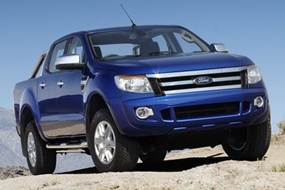It is only a decade ago that the mode of transport in China was a bicycle. Those days have really changed, and China is now the dominant marketplace in the world’s auto industry. Last year Porsche had a 22 percent increase in profits, riding on the back of a 22 percent increase in sales in China. In fact, they sold more Porsches in China than anywhere else! The starving millions in China that we were told about as children are now the well-fed millionaires!
The latest manufacturer to pledge itself to China is Ford, which is spending USD 760 million to build a new plant in Hangzhou, which should be able to produce 250,000 vehicles, which is one of the eight plants that Ford has committed to Asia (including our new one on the Eastern Seaboard). Ford expect that the new plant will bring them close to full strength in Asia by 2015.
 New Ford Ranger.
New Ford Ranger.
When you look at the number of vehicles produced and sold by GM and VW, you can see just why Ford had to join the race. GM sold 2.55 million cars, and VW close behind at 2.26 million vehicles. Ford sold under 400,000. The aim with the new plants is to increase sales to 1.2 million vehicles in 2015, but even at 1.2 million, they are still a long way behind rival GM.
With Ford’s stated aim of increasing global sales by 50 percent in this decade, it will need a very strong presence in Asia, and China in particular. Ford estimates that by 2020, 33 percent of its sales will come from Asia and Africa.
On the local front, the new Ranger and its mechanical twin, the Mazda BT-50, have been racking up such strong sales (8,500 delivered since December/January) that the Ford Mazda Alliance is further developing the AAT plant in Rayong with an injection of USD 27 million.
The extended plant will increase the output of their pick-ups by another 20,000 units. With the combined factors of the 300 baht minimum wage, and a shortage of trained labor, Ford/Mazda’s new plant will feature robotics to counteract this, and they also claim that this will reduce production time and increase total output. (The auto industry has the potential to be in a state of flux over the next 18 months.)




